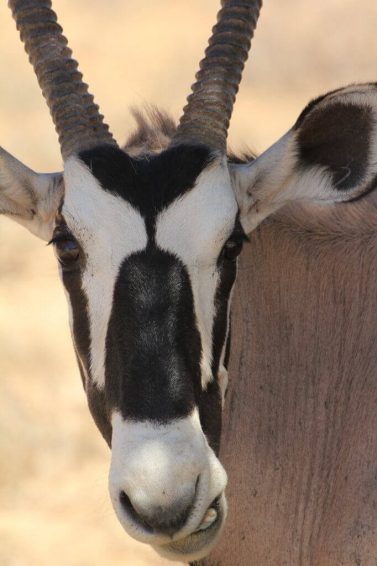Horns Of Gemsbok :Oryx Gazella Mammals
In the Kalahari, the silhouettes of these huge antelopes with them imposing horns often break the clean lines of the dunes at dusk and dawn.
Physical Description of Gemsbok
The light brown to gray coats of adult Gemsbok fades to a lighter color at the back of the rump, while the tail is black and long. The top of the legs are dark brown and dark brown stripes run low on both the sides, leading to the white stomach.Gemsboks’ faces are white with a black patch on the nose and a smaller black patch on the forehead below the horns. They also have two black bands running down on either side of the face. Their horns are straight and grooved with an average size of 85cm, but can reach lengths of 125cm.
Males and females look the same and Gemsbok can weigh between 210kg and 240kg. An adult Gemsbok stands 1, 2 meters tall. They have a life expectancy of around 19 years. Gemsbok developed special adaptations to withstand the heat and dry conditions of the semi-desert areas.
Habitat, Social Structure and Reproduction of Gemsbok
Gemsbok prefers the open savanna of semi-desert areas and in open dry bush veld. In the Kalahari, especially in the Kgalagadi Transfrontier Park, they often graze on the dunes and in dry riverbeds. The average herd size is 12 animals consisting of cows and calves. Adult male Gemsbok are territorial and and will be solitary or form groups of 2 to 3 males.Gemsbok graze both during the day and during the night.
According to the Department of Tourism Botswana, Gemsbok – Mammals – Flora and Fauna-Tourism, Botswana: Ministry of Trade, Industry, Wildlife and Tourism of the Republic of Botswana – Department of Tourism, females become sexually mature at about 2 years of age and can conceive almost immediately. Pregnant females move away from the herd just before calving.
Females give birth to one totally brown calf any time during the year after a gestation period of approximately 9 months. Gemsbok calves are often hidden away for several weeks after birth before they are introduced into the herd. In the Kalahari the number of newborn calves normally peaks during September, but this may vary with different rainfall patterns.

Which Predators Hunt Gemsbok?
Due to the Gemsbok’s size, the number of predators posing a danger to adult Gemsbok is limited to either large carnivores or well-orchestrated attackers.
In the Kalahari, lions are well adapted to hunting Gemsbok grazing in the dunes. The impressive horns of the Gemsbok, affords it a measure of protection and when Gemsbok sees the attack in time, it pushes the rear end of its body into a thorny bush. The thorns protect the Gemsbok from attacks from behind while it uses the horns to fend off attacks from the front. Gemsbok often grazes together while looking in opposite directions and thereby limiting the chance of a surprise attach from behind.
Lions are not the Gemsbok’s only enemy. The well-orchestrated attacks of Spotted Hyena and Wild Dogs also pose a threat to their safety. The sheer size of the hunting party renders the impressive horns of the Gemsbok useless against the ferocious attacks of packs of Spotted Hyena and Wild Dogs.
Calves and young adults also fall prey to cheetah in the open grasslands and leopard in the riverbeds. The Gemsbok is truly the flagship antelope of the Kalahari. You may also read about: Mammals of Africa’s Desert Areas – Springbok : Icons of Africa’s desert


